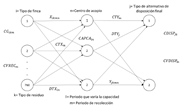Design of a Network of Reverse Logistics: Case Study Usochicamocha - Boyacá
Main Article Content
Keywords
Reverse logistics, pesticides, return of containers, linear programming, recycling, safe container disposal
Abstract
This paper presents the final results of an advance investigation in the Usochicamocha irrigation district of the Department of Boyacá - Colombia, which faces a problem because of the non - return and collection of al the empty packaging and packaging of pesticides that generate the farmers. Due to the above, the research proposes a configuration and operation of the reverse logistics network (LI) for the collection, collection and final disposal of pesticide residues in that area, for which a linear programming model was developed mixed in order to define both the quantities to be collected and transported to final disposal and to evaluate the possibility of opening new collection centers. The results of the mathematical model show that, on average, 5 kg of waste are collected on each farm and 1106.58 kg are sent to safe disposal and 1292.31 kg to be recycled.
Downloads
References
[2] A. Diabat, D. Kannan, M. Kaliyan, and D. Svetinovic, “An optimization model for product returns using genetic algorithms and artificial immune system,” Resources, conservation and recycling, vol. 74, pp. 156–169, 2013.
[3] M. Gallo, T. Murino, and E. Romano, “The simulation of hybrid logic in reverse logistics network,” Selected Topics in System Science and Simulation Engineering, pp. 378–384, 2010.
[4] D. S. Rogers and S. Ronald, “Going backwards: reverse logistics trends and practices,” 1999.
[5] M. J. Álvarez-Gil, P. Berrone, F. J. Husillos, and N. Lado, “Reverse logistics, stakeholders’influence, organizationalslack,and managers’posture,” Journal of business research, vol. 60, no. 5, pp. 463–473, 2007.
[6] J. R. Stock, Reverse logistics: White paper. Council of Logistics Management, 1992.
[7] D. S. Rogers and R. Tibben-Lembke, “An examination of reverse logistics practices,” Journal of business logistics, vol. 22, no. 2, pp. 129–148, 2001.
[8] M. Fleischmann, J. M. Bloemhof-Ruwaard,R. Dekker, E. Van der Laan, J. A. Van Nunen, and L. N. Van Wassenhove, “Quantitative models for reverse logistics: A review,” European journal of operational research, vol. 103, no. 1, pp. 1–17, 1997.
[9] C. R. Carter and L. M. Ellram, “Reverse logistics: a review of the literature and framework for future investigation,” Journal of business logistics, vol. 19, no. 1, p. 85, 1998.
[10] J. R. Stock and J. P. Mulki, “Product returns processing: an examination of practices of manufacturers, wholesalers/distributors, and retailers,” Journal of Business Logistics, vol. 30, no. 1, pp. 33–62, 2009.
[11] V. D. R. Guide Jr and L. N. Van Wassenhove, “Or forum—the evolution of closed-loop supply chain research,” Operations research, vol. 57, no. 1, pp. 10–18, 2009.
[12] T.-L. Hu, J.-B. Sheu, and K.-H. Huang, “A reverselogistics cost minimization model for the treatment of hazardous wastes,” Transportation Research Part E: Logistics and Transportation Review, vol. 38, no. 6, pp. 457–473, 2002.
[13] R. Verma, G. R. Plaschka,B. Hanlon, A. Livingston, and K. Kalcher,“Predicting customer choice in services using discrete choice analysis,” IBM Systems Journal, vol. 47, no. 1, pp. 179–191, 2008.
[14] C. Lee and T. Chan, “Development of rfid-based reverse logistics system,” Expert Systems with Applications, vol. 36, no. 5, pp. 9299–9307, 2009.
[15] M. Hosseinzadeh and E. Roghanian, “An optimization model for reverse logistics network under stochastic environment using genetic algorithm,” International Journal of Business and Social Science, vol. 3, no. 12, pp. 1–17, 2012.
[16] S. Elfvendahl, M. Mihale, M. A. Kishimba, and H. Kylin, “Pesticide pollution remains severe after cleanup of a stockpile of obsolete pesticides at vikuge, tanzania,” AMBIO: A Journal of the Human Environment, vol. 33, no. 8, pp. 503–508, 2004.
[17] A. Buczynska and I. Szadkowska-Stanczyk, “Identification of health hazards to rural population living near pesticide dump sites in poland,” International journal of occupational medicine and environmental health, vol. 18, no. 4, pp. 331–339, 2005.
[18] I. D. Haylamicheal and M. A. Dalvie, “Disposal of obsolete pesticides, the case of ethiopia,” Environment international, vol. 35, no. 3, pp. 667–673, 2009.
[19] W. J. Ladeira, A. E. Maehler, and L. F. M. d. Nascimento, “Logística reversa de defensivos agrícolas: fatores que influenciam na consciência ambiental de agricultores gaúchos e mineiros,” Revista de Economia e Sociologia Rural, vol. 50, no. 1, pp. 157–174, 2012.
[20] E. D. C. Castañeda, A. M. F. Benítez, and J. D. S. Rodríguez, “Diseño de un sistema de logística inversa para la recolección de envases y empaques vacíos de plaguicidas,” Revista Ingeniería Industrial, vol. 12, no. 2, 2013.
[21] R. K. Yin, Case study research: Design and methods. Sage publications, 2013.
[22] H. A. Taha, Investigación de operaciones. Pearson Educación, 2004.

